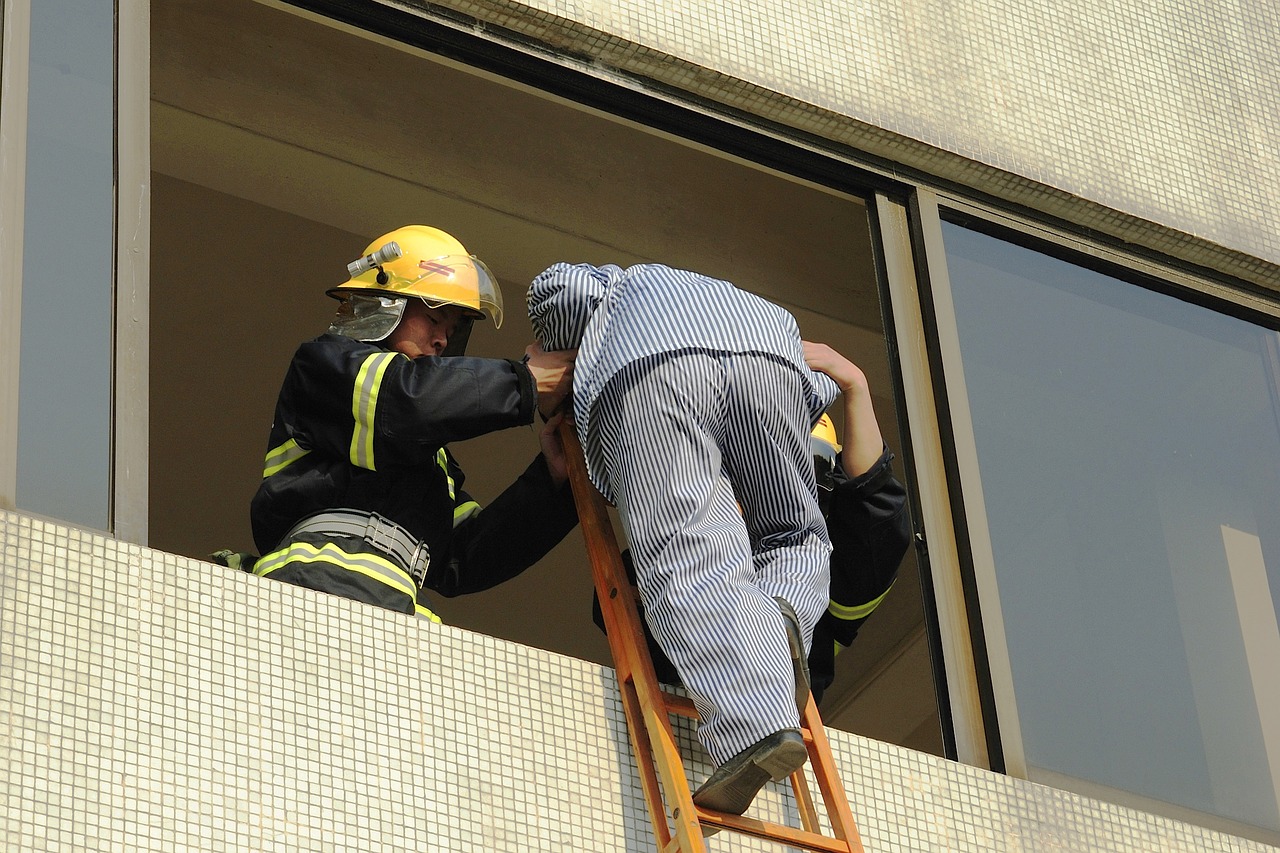A Roadmap to Safety: Understanding Human Behavior
In our fast-paced world, safety is often at the forefront of our minds, yet the intricacies of human behavior can sometimes complicate our understanding of it. Why do people take risks even when they know the dangers? How do past experiences shape our reactions to potential threats? This article will explore the fascinating landscape of human behavior in the context of safety, diving deep into the psychological factors that drive our decisions and actions. By understanding these elements, we can create more effective safety protocols and ultimately foster a safer environment for everyone.
When we talk about safety, we must first understand the psychological factors that influence our behavior. Our perception of risk is not just about the actual danger present; it’s heavily influenced by our motivation, past experiences, and even our cultural background. For instance, someone who has experienced a traumatic event may perceive a situation as more dangerous than someone who hasn't. This difference in perception can lead to varying safety behaviors.
Moreover, motivation plays a crucial role. Are we motivated by fear, the desire to protect loved ones, or perhaps a sense of duty? These motivations can lead us to make decisions that prioritize safety, but they can also lead to overconfidence in our abilities, which can be equally dangerous. Understanding these psychological drivers is essential for anyone looking to improve safety protocols, whether in the workplace or at home.
When faced with a potentially dangerous situation, how do we assess the risks involved? This decision-making process is often complex and influenced by various cognitive processes. People tend to rely on heuristics—mental shortcuts that simplify decision-making. While these can be helpful, they can also lead to errors in judgment.
Emotions are powerful influencers of decision-making. Consider how fear can either paralyze us or propel us to action. In some cases, fear can lead to heightened caution and adherence to safety protocols. In contrast, anxiety may cause individuals to avoid situations altogether, potentially leading to missed opportunities for learning or growth. On the flip side, overconfidence can lead to reckless behavior, where individuals underestimate risks and overestimate their ability to handle dangerous situations.
When under stress, individuals employ various coping mechanisms that can significantly impact their safety behaviors. These can be classified into two categories: adaptive and maladaptive strategies. Adaptive strategies, like seeking help or using problem-solving techniques, can enhance safety outcomes, whereas maladaptive strategies, such as denial or avoidance, can exacerbate risks. Understanding these coping mechanisms is vital for developing effective safety training programs.
It’s fascinating how our behavior changes in group settings. Group dynamics can dramatically influence individual behavior, especially in safety contexts. Peer pressure can lead to risky decisions, while social norms can either promote safe behaviors or encourage recklessness. For example, if a group of friends decides to take a shortcut through a dangerous area, an individual may feel compelled to follow suit, even if they recognize the risks involved. Understanding these dynamics can help organizations foster a culture of safety that encourages positive behaviors among groups.
Cognitive biases can lead to flawed decision-making regarding safety. For instance, optimism bias is the tendency to believe that we are less likely to experience negative events compared to others. This can result in individuals taking unnecessary risks. Additionally, confirmation bias leads people to seek information that supports their beliefs while ignoring contrary evidence. Recognizing these biases is crucial for effective risk management and decision-making.
Cultural factors heavily influence how safety is perceived and prioritized. Different cultures have varying attitudes toward risk-taking and safety protocols, which can significantly impact behavior. For instance, in some cultures, strict adherence to safety regulations is paramount, while in others, a more relaxed approach may prevail. This cultural lens shapes how individuals respond to safety training and protocols.
Understanding the balance between individual and collective responsibility in safety is essential. Different cultures approach accountability in unique ways, which can affect safety practices. In some cultures, collective responsibility is emphasized, leading to a shared commitment to safety. In contrast, others may focus more on individual accountability, which can create a sense of isolation in safety practices. Recognizing these differences can help tailor safety programs to fit the cultural context of a group.
Effective education and training can significantly enhance safety behaviors. Knowledge is power, and when individuals are equipped with the right information and skills, they are better prepared to handle safety challenges. Training programs that incorporate real-life scenarios and hands-on experience can foster a deeper understanding of safety protocols and improve responses to emergencies.
- What are the key psychological factors that influence safety behavior? Psychological factors include perception, motivation, past experiences, and emotional responses.
- How do cognitive biases affect decision-making in safety contexts? Cognitive biases can lead to flawed judgments, such as underestimating risks or overestimating one's abilities.
- Why is culture important in understanding safety perception? Cultural attitudes toward risk and safety can vary significantly, affecting how individuals respond to safety protocols.
- What role does education play in enhancing safety behaviors? Education equips individuals with the knowledge and skills necessary to make informed safety decisions.

The Psychology of Safety
Understanding the psychological factors that drive human behavior is crucial for creating effective safety protocols. Our perception of safety is not merely a product of the environment; it is deeply influenced by our thoughts, emotions, and past experiences. For instance, when faced with a potential hazard, individuals often rely on their instincts and previous encounters to gauge the level of risk. This mental process can be likened to a mental filter through which we view the world around us. If someone has had a negative experience in a similar situation, their perception of risk is likely to be heightened, leading to more cautious behavior.
Moreover, motivation plays a pivotal role in how we respond to safety challenges. People are often driven by a desire to protect themselves and their loved ones. This protective instinct can sometimes lead to overestimating risks or, conversely, underestimating them, depending on the context. For example, a parent may be overly cautious about their child playing near water due to a past incident, while another might dismiss the dangers of a busy road because they have never experienced an accident. This inconsistency highlights the complex relationship between motivation and perception.
Another significant factor is the influence of social norms. The behaviors and attitudes of those around us can greatly affect our own safety-related actions. If a group of friends regularly engages in risky activities, an individual may feel pressured to conform, even if they personally perceive those activities as dangerous. This is where the psychology of safety intertwines with group dynamics, creating a fascinating yet complex web of influences that can lead to either enhanced safety or increased risk-taking.
In addition, our past experiences shape our safety behaviors. When we encounter a situation that challenges our sense of safety, we often draw on our previous knowledge and experiences to navigate it. This can create a cycle where positive experiences reinforce safe behavior, while negative experiences can lead to a heightened sense of caution or even avoidance. For instance, someone who has successfully navigated a fire drill may feel more confident in their ability to handle emergencies in the future, while someone who has experienced a fire may develop a lasting fear that affects their behavior in similar situations.
Ultimately, understanding these psychological underpinnings is essential for developing effective safety strategies. By recognizing how perception, motivation, and past experiences shape our actions, we can create safety protocols that resonate with individuals on a deeper level, making them more likely to adhere to safety measures. This understanding can lead to a more proactive approach to safety, where individuals are empowered to make informed decisions based on their unique psychological profiles.
- What are the main psychological factors that influence safety behavior?
The main factors include perception, motivation, past experiences, and social norms. Each of these elements plays a significant role in how individuals assess risks and make decisions regarding safety.
- How do emotions impact our safety decisions?
Emotions like fear and anxiety can lead to heightened caution, while overconfidence may result in reckless behavior. Understanding these emotional responses is crucial for improving safety practices.
- Can group dynamics affect individual safety behaviors?
Yes, group dynamics can significantly influence individual behavior. Peer pressure and social norms often lead individuals to conform to the behaviors of their peers, which can either enhance or undermine safety.

When it comes to safety, the way we assess risks and make decisions can be a matter of life and death. Think about it: every day, we navigate a world filled with potential hazards, from crossing the street to operating heavy machinery. But how do we determine what’s safe and what isn’t? The process of risk assessment is not just a mechanical calculation; it’s a complex interplay of cognitive processes, emotions, and even social influences. Each decision we make is influenced by our past experiences, knowledge, and sometimes, our gut feelings.
At the core of risk assessment is the ability to evaluate both the likelihood and the severity of a potential threat. This involves a series of cognitive processes that can be both rational and irrational. For instance, when faced with a dangerous situation, we often rely on heuristics—mental shortcuts that help us make quick decisions. While these can be useful, they can also lead to biases that cloud our judgment. One common bias is the optimism bias, where individuals believe they are less likely to experience negative events compared to others. This can lead to underestimating risks and, consequently, making unsafe choices.
Moreover, the context in which a decision is made plays a significant role. In high-stress situations, our emotional state can dramatically alter our perception of risk. For example, when panic sets in, people may either freeze and fail to act or rush into decisions without fully considering the consequences. This emotional response can skew our risk assessment, making it crucial to remain calm and collected. Fear and anxiety can paralyze us, while overconfidence can lead to reckless behavior. The challenge lies in finding that sweet spot—being cautious yet assertive.
To illustrate, let’s consider a scenario: you’re at a crowded event, and suddenly you hear a loud bang. Your immediate reaction might be to flee, driven by fear. However, if you take a moment to assess the situation—looking for exits, observing others' reactions—you might find that it was just a firecracker. This example highlights the importance of calm decision-making in risk assessment. But how do we train ourselves to respond better in such situations?
One effective way is through education and training. Understanding the principles of risk assessment can empower individuals to make more informed decisions. For instance, safety drills can help people practice their responses to emergencies, making them more adept at evaluating risks in real time. The more we familiarize ourselves with potential dangers, the better equipped we are to handle them.
Additionally, it’s vital to recognize that decision-making doesn’t happen in a vacuum. Social influences can sway our choices significantly. Group dynamics often play a crucial role in how risks are perceived and acted upon. Peer pressure can lead individuals to take unnecessary risks, while a supportive group can encourage safer behaviors. Therefore, fostering a culture of safety within groups can enhance overall decision-making processes.
In summary, risk assessment and decision-making are multifaceted processes influenced by cognitive biases, emotional responses, and social dynamics. By understanding these factors, we can improve our ability to navigate risks effectively. Whether it's through education, training, or fostering supportive environments, enhancing our decision-making skills can lead to safer outcomes in various situations.
- What is risk assessment?
Risk assessment is the process of identifying and evaluating potential risks to make informed decisions about safety. - How do emotions affect risk assessment?
Emotions like fear and anxiety can cloud judgment, leading to either over-cautiousness or reckless behavior. - Can training improve decision-making in emergencies?
Yes, training helps individuals practice their responses to emergencies, making them more adept at evaluating risks in real-time. - What role does social influence play in decision-making?
Group dynamics can significantly affect individual behavior, with peer pressure sometimes leading to riskier decisions.

Emotions are like the hidden engines driving our decision-making processes, especially in the realm of safety. Have you ever noticed how your heart races when you perceive danger? This is not just a physical response; it’s a complex interplay of feelings that can significantly influence our actions. Fear, anxiety, and even overconfidence can lead us down very different paths when it comes to assessing risks. For instance, when faced with a hazardous situation, fear might push someone to take immediate action to protect themselves, while another person might become paralyzed by anxiety, unable to make a decision at all.
Consider a moment when you had to make a quick decision. Perhaps you were driving and a car suddenly swerved into your lane. In that split second, your emotions kicked in, guiding your response. This is where the psychological concept of emotional intelligence comes into play. Those who can recognize and manage their emotions tend to navigate dangerous situations more effectively. They not only understand their own feelings but can also empathize with others, allowing for better teamwork in safety-critical scenarios.
Moreover, emotions can create a double-edged sword effect. On one hand, fear can motivate individuals to adhere strictly to safety protocols, ensuring that they take the necessary precautions. On the other hand, excessive fear can lead to avoidance behaviors, where individuals might shun situations altogether, missing out on opportunities for growth and learning. This is particularly evident in workplace environments where safety training is crucial. Employees who feel anxious about potential hazards may shy away from engaging fully in their tasks, which can ironically lead to more accidents due to a lack of awareness.
Furthermore, overconfidence can also skew our perception of safety. It’s that feeling of invincibility that might lead someone to take unnecessary risks, believing they can handle any situation that arises. For example, a seasoned driver might think they can text while driving because they feel they’ve mastered the road. This overconfidence can cloud judgment and lead to disastrous outcomes, illustrating the importance of maintaining a balanced emotional state when making decisions related to safety.
In stressful situations, individuals often rely on various coping mechanisms to manage their emotions. These can be categorized into two main types: adaptive and maladaptive strategies. Adaptive strategies, such as seeking support or practicing mindfulness, can enhance decision-making and promote safety. Conversely, maladaptive strategies, like denial or substance abuse, can exacerbate risks and lead to poor safety outcomes. Understanding these emotional responses can be pivotal in training programs aimed at enhancing safety behaviors.
In conclusion, emotions are a fundamental aspect of human behavior that cannot be overlooked when discussing safety. They can propel us towards protective actions or lead us into dangerous territory. By fostering emotional awareness and resilience, we can improve our safety practices and decision-making processes, ultimately creating a safer environment for everyone involved.
- How do emotions influence decision-making in safety contexts? Emotions can either motivate protective actions or lead to avoidance and risk-taking behaviors, impacting overall safety.
- What are adaptive coping mechanisms? Adaptive coping mechanisms include strategies like seeking support, problem-solving, and mindfulness that help manage stress effectively.
- Can overconfidence be dangerous? Yes, overconfidence can lead individuals to underestimate risks and take unnecessary chances, which may result in accidents or injuries.
- How can emotional intelligence improve safety? By enhancing emotional intelligence, individuals can better understand their emotions and those of others, leading to improved teamwork and safer decision-making.

When the unexpected happens, our brains go into overdrive. Stressful situations can trigger a whirlwind of emotions, and how we cope with that stress can make all the difference. Picture this: you're in a high-pressure environment, maybe a job site or during a natural disaster. Your heart races, your palms sweat, and suddenly, it's not just about what’s happening around you, but how you respond to it. Coping mechanisms are the tools we use to navigate these turbulent waters, and they can be broadly categorized into two types: adaptive and maladaptive strategies.
Adaptive coping mechanisms are the ones that help us manage stress effectively. They can include techniques like deep breathing, seeking social support, or even engaging in physical activity. For instance, when faced with a stressful situation, taking a moment to breathe deeply can ground you and help regain focus. On the other hand, maladaptive coping mechanisms tend to exacerbate stress rather than alleviate it. These might include avoidance, substance abuse, or even aggressive behaviors. Imagine someone who, instead of addressing their anxiety about a safety protocol, chooses to ignore it entirely. This avoidance can lead to disastrous outcomes, not just for themselves but for others around them.
Understanding these mechanisms is crucial, especially in safety-critical environments. For example, a worker who relies on adaptive strategies is more likely to remain calm and make informed decisions during an emergency. In contrast, someone using maladaptive strategies might panic, leading to poor choices that could endanger themselves and others. It’s a classic case of “fight or flight,” where our response to stress can either save the day or create chaos.
Let’s take a closer look at some common coping strategies:
- Problem-solving: Actively seeking solutions to the issues at hand, rather than just reacting emotionally.
- Emotional regulation: Managing one’s emotions to maintain composure and clarity.
- Seeking support: Reaching out to friends, family, or colleagues for help and perspective.
In stressful situations, it's also essential to recognize that the effectiveness of these mechanisms can vary from person to person. Cultural background, personal experiences, and even personality traits play a significant role in shaping how we cope. For instance, in some cultures, expressing emotions openly is encouraged, while in others, it may be seen as a sign of weakness. This cultural lens can significantly impact how individuals respond to stress and what coping strategies they find most effective.
Moreover, the workplace environment can foster either adaptive or maladaptive coping mechanisms. Organizations that prioritize mental health and provide resources for stress management tend to cultivate a culture of safety and resilience. Training programs that teach employees how to cope with stress effectively can lead to better safety outcomes, as individuals feel more equipped to handle emergencies. In contrast, a lack of support can lead to a culture of silence, where employees feel they must deal with stress alone, often resorting to unhealthy coping strategies.
In summary, understanding coping mechanisms in stressful situations is not just about individual behavior; it’s about creating an environment where adaptive strategies can thrive. By fostering a culture that encourages healthy coping, organizations can enhance safety and improve overall well-being. After all, when the going gets tough, it’s not just about surviving; it’s about thriving under pressure.
Q: What are adaptive coping mechanisms?
A: Adaptive coping mechanisms are strategies that help individuals manage stress effectively, such as problem-solving, emotional regulation, and seeking support.
Q: How do maladaptive coping mechanisms affect safety?
A: Maladaptive coping mechanisms can lead to poor decision-making and increased risk in stressful situations, potentially endangering both the individual and others.
Q: Why is understanding coping mechanisms important in safety contexts?
A: Understanding coping mechanisms helps organizations create supportive environments that promote effective stress management, ultimately leading to better safety outcomes.

When it comes to safety, the influence of group dynamics cannot be underestimated. Imagine a scenario where a group of friends decides to go hiking. Each individual's decision-making process is not solely based on personal judgment but is also significantly affected by the group. This phenomenon can be explained through the lens of social psychology, where the behavior of individuals is shaped by their interactions with others. Have you ever noticed how people often conform to the opinions of their peers, even if it might not be the safest choice? This is a classic example of group dynamics at play.
In high-pressure situations, such as emergency evacuations or workplace safety drills, group dynamics can lead to both positive and negative outcomes. On one hand, a cohesive group can enhance safety by promoting collective awareness and encouraging individuals to follow safety protocols. On the other hand, peer pressure can lead to risky behaviors, as individuals may feel compelled to act against their better judgment to fit in. For instance, if one person decides to take a shortcut through a hazardous area, others might follow suit, thinking, “If they’re doing it, it must be okay.” This herd mentality can have dire consequences.
Furthermore, social norms play a crucial role in shaping safety behavior within groups. If a group has a culture of prioritizing safety, members are more likely to adopt safe practices. Conversely, if the norm leans towards risk-taking, individuals may disregard safety measures. This is particularly evident in workplaces where safety culture is either strong or weak. A positive safety culture fosters open communication and encourages employees to voice concerns, while a negative culture can silence individuals, leading to increased risks.
The impact of group dynamics is also evident in how decisions are made. Groupthink, for example, is a psychological phenomenon where the desire for harmony or conformity results in irrational or dysfunctional decision-making outcomes. In safety contexts, this can mean that critical safety concerns are overlooked because everyone wants to maintain the peace. It’s essential to cultivate an environment where diverse opinions are welcomed and valued, as this can lead to better safety outcomes.
To illustrate these points, consider the following table that summarizes the effects of group dynamics on safety behavior:
| Group Dynamic | Positive Impact on Safety | Negative Impact on Safety |
|---|---|---|
| Peer Support | Encourages adherence to safety protocols | Can lead to complacency if everyone feels safe |
| Social Norms | Creates a culture of safety | May promote risk-taking if norms are not safety-oriented |
| Groupthink | Can streamline decision-making | Overlooks critical safety issues |
In conclusion, understanding the influence of group dynamics is essential for enhancing safety in various environments. By fostering a culture that values safety and encourages open communication, we can mitigate the negative impacts of group behavior and promote safer practices. So, next time you find yourself in a group setting, remember how your decisions can ripple through the group, affecting everyone’s safety.
- What are group dynamics? Group dynamics refer to the behavioral and psychological processes that occur within a social group, influencing how individuals interact and make decisions.
- How can group dynamics affect safety? Group dynamics can lead to both positive and negative safety outcomes, depending on the group's culture, norms, and decision-making processes.
- What is groupthink? Groupthink is a psychological phenomenon where the desire for group harmony leads to poor decision-making, often resulting in overlooked safety concerns.
- How can we promote a positive safety culture? Encouraging open communication, valuing diverse opinions, and reinforcing safety protocols can help establish a positive safety culture.

Cognitive biases are like invisible glasses through which we view the world, often distorting our perception of reality. When it comes to safety behavior, these biases can lead individuals to make decisions that may not align with the actual risks involved. For example, the **optimism bias** is a common phenomenon where people believe they are less likely to experience negative events compared to others. This might lead someone to engage in risky behavior, thinking, "It won't happen to me!" Such biases can create a false sense of security, causing individuals to underestimate the dangers present in their environment.
Another significant bias is the **confirmation bias**, where individuals tend to favor information that confirms their pre-existing beliefs. In safety contexts, this means that if someone believes a certain safety protocol is unnecessary, they may ignore evidence suggesting otherwise. This selective attention can lead to dangerous complacency, as individuals dismiss critical safety information that could protect them and others.
Moreover, the **availability heuristic** plays a crucial role in shaping safety behavior. This cognitive shortcut leads individuals to assess the likelihood of an event based on how easily they can recall similar instances. For instance, if someone recently heard about a workplace accident, they may overestimate the likelihood of such an event occurring again, leading to either excessive caution or irrational fear. This can create a paradox where the very act of trying to enhance safety can become counterproductive due to skewed perceptions.
To further illustrate these biases, consider the following table that summarizes some common cognitive biases and their potential impacts on safety behavior:
| Cognitive Bias | Description | Impact on Safety Behavior |
|---|---|---|
| Optimism Bias | The belief that one is less likely to experience negative events than others. | Underestimation of risks, leading to risky behavior. |
| Confirmation Bias | The tendency to search for, interpret, and remember information that confirms one’s beliefs. | Ignoring critical safety information, leading to dangerous complacency. |
| Availability Heuristic | Assessing the likelihood of an event based on how easily examples come to mind. | Overestimating or underestimating risks based on recent experiences. |
Recognizing these cognitive biases is essential for improving safety practices. By understanding how our minds work, we can take proactive steps to mitigate their effects. For instance, organizations can implement training programs that educate employees about these biases, encouraging them to think critically about their safety decisions. Additionally, fostering an environment where safety concerns can be openly discussed can help counteract the effects of confirmation bias, allowing for a more comprehensive understanding of risks.
Ultimately, addressing cognitive biases in safety behavior is not just about individual awareness; it’s about creating a culture of safety where everyone feels responsible for their actions. By acknowledging these biases, we can make more informed decisions that prioritize safety, reduce risks, and create a safer environment for all.
- What are cognitive biases? Cognitive biases are systematic patterns of deviation from norm or rationality in judgment, which can affect decision-making.
- How do cognitive biases impact safety behavior? They can lead to flawed assessments of risk and influence individuals to make unsafe choices based on distorted perceptions.
- Can training help mitigate cognitive biases? Yes, training can raise awareness about these biases and equip individuals with strategies to counteract them.
- What is the optimism bias? It is the belief that one is less likely to face negative outcomes compared to others, often leading to risky behavior.

When we think about safety, it’s easy to assume that everyone views it through the same lens. However, the truth is that cultural factors play a pivotal role in how safety is perceived and prioritized across different societies. Just like a painter chooses specific colors to create a masterpiece, cultures select their own values and beliefs that shape their understanding of safety. For instance, in some cultures, safety might be seen as a collective responsibility, while in others, it may be viewed as an individual obligation. This divergence can significantly influence how safety protocols are developed and followed.
One of the most striking aspects of culture is its ability to shape attitudes towards risk-taking behavior. In cultures that emphasize individualism, people might feel more empowered to take risks, believing that personal freedom is paramount. Conversely, in collectivist cultures, individuals may be more cautious, prioritizing the well-being of the group over their own desires. This difference can manifest in various environments, from workplaces to public spaces, affecting everything from safety training to emergency response strategies.
To illustrate this point, consider the following table that outlines how different cultures approach safety:
| Culture Type | Approach to Safety | Examples of Behavior |
|---|---|---|
| Individualistic | Emphasis on personal responsibility | Taking risks for personal gain, less adherence to safety protocols |
| Collectivist | Focus on group welfare | Following strict safety guidelines, prioritizing team safety over individual desires |
Moreover, the way safety is communicated within different cultures can also vary greatly. In some societies, direct communication about risks and safety measures is encouraged, while in others, it might be considered impolite or unnecessary. This can lead to misunderstandings and a lack of adherence to safety measures. For example, if a safety protocol is introduced without a clear understanding of its importance within a specific cultural context, it may be ignored or resisted. This highlights the necessity for organizations to tailor their safety messages to fit the cultural backgrounds of their employees.
In addition, cultural narratives and historical experiences can shape perceptions of safety. For instance, communities that have faced natural disasters may develop a heightened awareness of safety measures, leading to a culture of preparedness. On the other hand, cultures that have not experienced significant threats may adopt a more relaxed attitude towards safety, potentially increasing their vulnerability in risky situations. This variance underscores the importance of recognizing and respecting cultural differences when implementing safety protocols.
Ultimately, understanding the interplay between culture and safety perception is crucial for developing effective safety strategies. Organizations must not only recognize these cultural nuances but also incorporate them into their training and communication efforts. By doing so, they can foster a more inclusive and effective safety culture that resonates with all individuals, regardless of their background.
- How does culture influence safety in the workplace?
Cultural beliefs and values can shape how employees perceive risks and follow safety protocols, leading to variations in safety practices across different organizations. - Can safety training be effective across different cultures?
Yes, but it must be tailored to fit the cultural context of the participants to ensure that the training resonates and is taken seriously. - What role do historical experiences play in shaping safety perceptions?
Communities with a history of disasters may have a more proactive approach to safety, while others may be more complacent.

When it comes to safety, the debate between individual responsibility and collective responsibility often stirs up passionate discussions. On one hand, we have the notion that each person is accountable for their actions, making decisions that directly affect their safety and the safety of those around them. On the other hand, collective responsibility emphasizes the idea that safety is a shared concern, where the actions of one can significantly influence the well-being of the entire group. But how do these two concepts interact, and why is it essential to understand their dynamics?
In many scenarios, individual responsibility is about personal choices—like wearing a seatbelt or following safety protocols in a workplace. These choices stem from a person's understanding of risks and their willingness to adhere to safety measures. However, when individuals operate in a group setting, their decisions can be swayed by the group's norms and expectations. This is where collective responsibility shines; it creates an environment where safety becomes a communal goal, encouraging everyone to look out for one another.
Consider a workplace scenario: if one employee neglects to follow safety protocols, it may not only endanger themselves but also put their colleagues at risk. This illustrates the need for a culture of collective responsibility, where everyone is motivated to uphold safety standards. In contrast, if everyone believes that safety is solely an individual concern, the potential for accidents increases dramatically. It's like a game of dominoes; one careless act can topple the entire structure of safety.
To further illustrate this point, let's take a look at the following table that contrasts individual and collective responsibility:
| Aspect | Individual Responsibility | Collective Responsibility |
|---|---|---|
| Definition | Accountability for one's own actions | Shared accountability among a group |
| Decision-Making | Based on personal risk assessment | Influenced by group norms and dynamics |
| Outcome | Can lead to personal safety, but risks group safety | Promotes a safer environment for all |
| Examples | Wearing protective gear | Implementing safety drills |
Moreover, the cultural context of a group can significantly affect how these responsibilities are perceived. In some cultures, the emphasis may be more on individual accountability, while in others, there may be a stronger focus on communal well-being. Understanding these cultural nuances can help organizations develop better safety protocols that cater to their specific environment.
In conclusion, while individual responsibility is crucial for personal safety, collective responsibility amplifies the effectiveness of safety measures. By fostering a culture where everyone feels accountable for the safety of themselves and their peers, we can create environments that not only minimize risks but also promote a sense of community and care. So, the next time you think about safety, remember that it’s not just about you—it's about all of us, working together to create a safer world.
- What is individual responsibility in safety? Individual responsibility refers to the accountability each person has for their own safety actions and decisions.
- How does collective responsibility enhance safety? Collective responsibility fosters an environment where everyone looks out for each other, leading to improved safety practices and awareness.
- Can cultural differences affect safety perceptions? Yes, cultural backgrounds can significantly influence how individuals and groups approach safety and accountability.
- What role does education play in promoting safety responsibility? Education provides individuals with the knowledge and skills necessary to understand risks and implement safety measures effectively.

When it comes to safety, education and training are the cornerstones of effective behavior modification. Imagine walking into a room filled with complex machinery. Would you feel safe operating it without proper training? Probably not! This is because our understanding and skills directly influence our confidence and decision-making in potentially hazardous situations. Education provides the theoretical knowledge, while training offers practical experience. Together, they create a robust framework for safe behavior.
One of the most compelling aspects of education and training is their ability to shape our responses to safety challenges. For instance, consider a fire drill in a workplace. Employees who have undergone thorough training will likely respond swiftly and efficiently, knowing exactly what to do and where to go. In contrast, those who haven't received such training may panic, leading to confusion and potentially dangerous situations. This illustrates how well-structured training programs can transform individuals from being passive observers into proactive participants in their own safety.
Furthermore, the impact of education extends beyond just the individual level; it can ripple through entire organizations. When a company prioritizes safety training, it fosters a culture of responsibility and awareness. Employees become more vigilant, not only for their own safety but also for their colleagues. This collective mindset can significantly reduce the likelihood of accidents. In fact, studies have shown that organizations with comprehensive safety training programs experience a dramatic decrease in workplace incidents.
To illustrate this point, let's take a look at a table comparing the incident rates in organizations before and after implementing a safety training program:
| Organization | Incident Rate Before Training | Incident Rate After Training |
|---|---|---|
| Company A | 15 incidents/year | 5 incidents/year |
| Company B | 20 incidents/year | 8 incidents/year |
| Company C | 10 incidents/year | 2 incidents/year |
As shown in the table, organizations that invested in safety training saw a significant drop in incident rates. This evidence underscores the importance of continuous learning and adaptation in maintaining safety standards. Moreover, training sessions that incorporate real-life scenarios and hands-on practice tend to be more effective. These methods not only engage participants but also help them internalize safety protocols in a way that theoretical learning alone cannot achieve.
In addition to enhancing individual and organizational safety, education and training also play a vital role in compliance with regulations. Many industries are governed by strict safety standards, and proper training ensures that employees are aware of these requirements. Failure to comply can lead to severe consequences, including fines and legal repercussions. Therefore, investing in education is not just a best practice; it’s a necessity for legal and operational integrity.
In summary, the impact of education and training on safety behavior cannot be overstated. It equips individuals with the knowledge and skills necessary to make informed decisions, fosters a culture of safety within organizations, and ensures compliance with regulatory standards. By prioritizing education and training, we take a significant step toward creating safer environments for everyone. So, the next time you think about safety, remember that knowledge is not just power; it’s a pathway to safety!
- Why is safety training important? Safety training is crucial as it prepares individuals to handle emergencies effectively, reducing the risk of accidents.
- How often should safety training be conducted? It’s recommended to conduct safety training regularly, at least once a year, or whenever there are significant changes in procedures or equipment.
- What are some effective training methods? Practical drills, simulations, and interactive workshops tend to be the most effective in engaging participants and reinforcing safety protocols.
- Can safety training reduce workplace incidents? Yes, studies have shown a direct correlation between effective safety training programs and reduced incident rates in the workplace.
Frequently Asked Questions
- What factors influence human behavior in safety contexts?
Human behavior in safety contexts is influenced by a variety of factors, including psychological elements like perception and motivation, emotional responses such as fear or anxiety, and past experiences. These elements shape how individuals assess risks and make decisions when faced with potential dangers.
- How do emotions affect decision-making related to safety?
Emotions play a crucial role in decision-making, particularly in safety scenarios. For instance, fear can lead to heightened caution, while overconfidence may result in reckless behavior. Understanding these emotional influences can help in developing better safety protocols and training programs.
- What are common cognitive biases that impact safety behavior?
Cognitive biases such as optimism bias, where individuals believe they are less likely to experience negative outcomes, and confirmation bias, which leads them to favor information that supports their preconceptions, can significantly skew judgment in safety-related situations. Recognizing these biases is essential for effective risk management.
- How does group dynamics influence safety decisions?
Group dynamics can heavily influence individual behavior, often amplifying peer pressure and social norms. In group settings, individuals may take greater risks or conform to unsafe practices simply to fit in, highlighting the importance of fostering a safety-conscious culture within teams.
- What role does culture play in safety perception?
Cultural factors greatly impact how safety is perceived and prioritized. Different cultures may have varying attitudes towards risk-taking and adherence to safety protocols, which can affect overall safety outcomes in diverse environments.
- How can education and training improve safety behaviors?
Effective education and training are vital for enhancing safety behaviors. By equipping individuals with the necessary knowledge and skills, they can better respond to safety challenges and make informed decisions in critical situations.
- What coping mechanisms do people use in stressful situations?
Individuals employ various coping mechanisms under stress, ranging from adaptive strategies like problem-solving and seeking support to maladaptive ones such as avoidance or denial. Understanding these mechanisms can provide insights into behavior during emergencies and help improve safety outcomes.
- What is the balance between individual and collective responsibility in safety?
Balancing individual and collective responsibility is essential for effective safety management. Different cultures may approach accountability differently, impacting how safety practices are implemented and followed within organizations and communities.



















